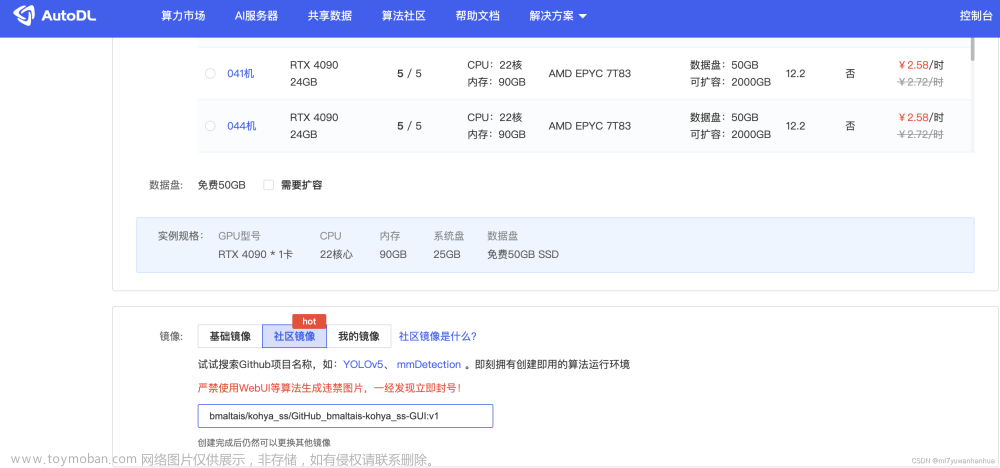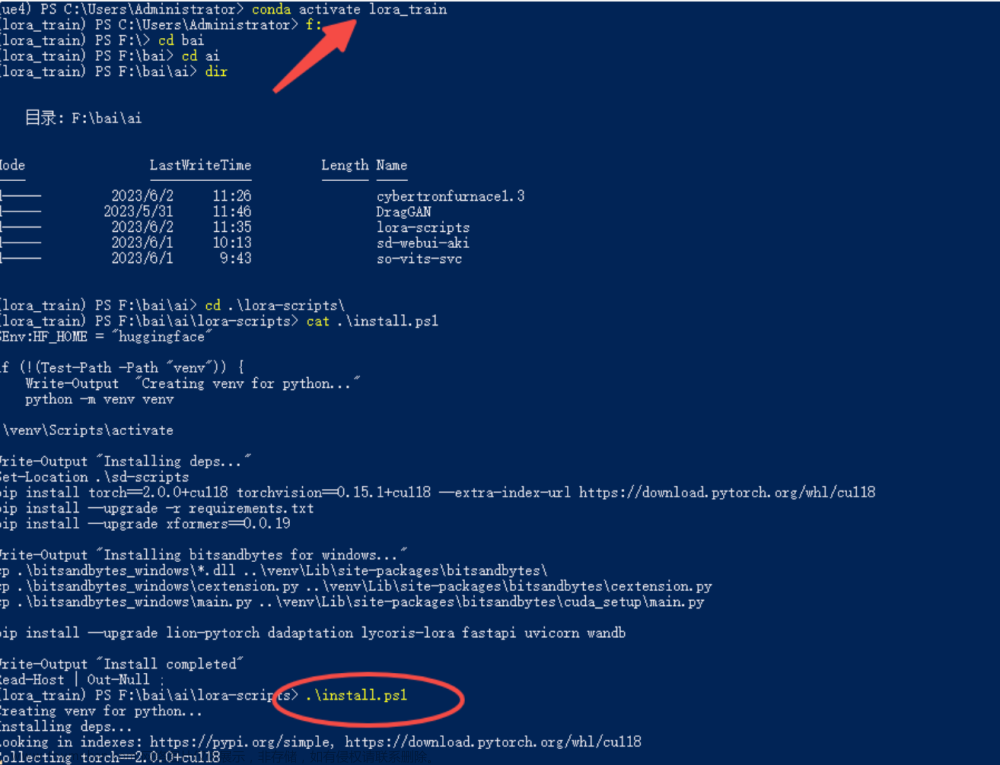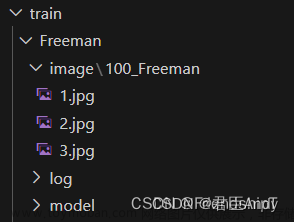注:代码来自https://github.com/darcula1993/diffusion-models-class-CN/blob/main/unit1/01_introduction_to_diffusers_CN.ipynb
本文是本人学习后的的尝试以及注解
一、准备工作
"""
这行命令使用pip工具来安装或升级多个Python包。具体来说,它执行以下操作:
-qq:这是pip的安静模式选项,它会减少输出信息,只显示关键信息,使安装过程更为简洁。
-U:这是pip的升级选项,它指示pip升级已经安装的包到最新版本(如果存在新版本)。
接下来,列出了要安装或升级的包:
diffusers:一个Python包
datasets:Hugging Face Transformers库的一部分,用于提供和管理各种自然语言处理(NLP)数据集的工具。
transformers:Hugging Face Transformers库,提供了预训练的深度学习模型,用于自然语言处理和文本生成任务。
accelerate:Hugging Face库的一部分,用于加速深度学习模型的训练和推理。
ftfy:一个用于处理Unicode文本的Python库,用于修复和清理不规范的Unicode文本。
pyarrow:正如前面所提到的,pyarrow是一个用于高效处理大规模数据集的Python库,支持列式存储和跨语言互操作性。
"""
%pip install -qq -U diffusers datasets transformers accelerate ftfy pyarrow# 登录hugging face
from huggingface_hub import notebook_login
notebook_login()显示下图则登陆成功:

# 安装 Git LFS 来上传模型检查点:
%%capture
!sudo apt -qq install git-lfs
!git config --global credential.helper store# 导入将要使用的库,并定义一些方便函数,稍后将会使用这些函数
import numpy as np
import torch
import torch.nn.functional as F
from matplotlib import pyplot as plt
from PIL import Image
def show_images(x):
"""Given a batch of images x, make a grid and convert to PIL"""
'''
输入参数:x,一个批量的图像数据(通常是PyTorch张量)。
功能:将输入的图像数据从范围(-1, 1)映射到(0, 1),然后将这些图像排列成一个网格,并将网格转换为PIL图像。
返回值:返回一个PIL图像,其中包含了排列好的输入图像网格。
'''
x = x * 0.5 + 0.5 # Map from (-1, 1) back to (0, 1)
grid = torchvision.utils.make_grid(x)
grid_im = grid.detach().cpu().permute(1, 2, 0).clip(0, 1) * 255
grid_im = Image.fromarray(np.array(grid_im).astype(np.uint8))
return grid_im
def make_grid(images, size=64):
"""Given a list of PIL images, stack them together into a line for easy viewing"""
'''
输入参数:images,一个包含多个PIL图像的列表,以及一个可选的size参数,用于指定图像的大小。
功能:将多个PIL图像按照指定的大小堆叠在一行上,以便于查看。
返回值:返回一个新的PIL图像,其中包含了堆叠在一行上的输入图像。
'''
output_im = Image.new("RGB", (size * len(images), size))
for i, im in enumerate(images):
output_im.paste(im.resize((size, size)), (i * size, 0))
return output_im
# Mac users may need device = 'mps' (untested)
device = torch.device("cuda" if torch.cuda.is_available() else "cpu")二、下载训练数据集
# 下载一个来自 Hugging Face Hub 的图像集。具体来说,是个 1000 张蝴蝶图像收藏集
import torchvision # 导入PyTorch的torchvision库
from datasets import load_dataset # 导入数据集
from torchvision import transforms # 导入PyTorch的transforms模块
# 使用load_dataset函数加载名为"huggan/smithsonian_butterflies_subset"的数据集中的训练集数据
dataset = load_dataset("huggan/smithsonian_butterflies_subset", split="train")
# 或者从本地文件夹加载图像数据
# dataset = load_dataset("imagefolder", data_dir="path/to/folder")
# 指定图像大小为32x32像素
image_size = 32
# 如果GPU内存不足,可以降低批次大小
batch_size = 64
# 定义数据增强操作
preprocess = transforms.Compose(
[
transforms.Resize((image_size, image_size)), # 调整图像大小
transforms.RandomHorizontalFlip(), # 随机水平翻转(数据增强)
transforms.ToTensor(), # 将图像转换为张量(数值范围从0到1)
transforms.Normalize([0.5], [0.5]), # 将图像像素值归一化到(-1, 1)的范围
]
)
# 定义一个用于对数据进行转换的函数
def transform(examples):
images = [preprocess(image.convert("RGB")) for image in examples["image"]]
return {"images": images}
# 将数据集的转换函数设置为上述定义的transform函数
dataset.set_transform(transform)
# 创建一个数据加载器,用于以批次方式提供转换后的图像数据
train_dataloader = torch.utils.data.DataLoader(
dataset, batch_size=batch_size, shuffle=True # 使用指定的批次大小和随机打乱数据
)
# 我们可以从中取出一批图像数据来看一看他们是什么样子:
xb = next(iter(train_dataloader))["images"].to(device)[:8]
print("X shape:", xb.shape)
show_images(xb).resize((8 * 64, 64), resample=Image.NEAREST)结果如下图所示:

三、定义管理器
我们的训练计划是,取出这些输入图片然后对它们增添噪声,在这之后把带噪的图片送入模型。在推理阶段,我们将用模型的预测值来不断迭代去除这些噪点。在diffusers中,这两个步骤都是由 管理器(调度器) 来处理的。噪声管理器决定在不同的迭代周期时分别加入多少噪声。
from diffusers import DDPMScheduler
noise_scheduler = DDPMScheduler(num_train_timesteps=1000)# 绘图查看输入 (x) 与噪声是如何在不同迭代周期中量化和叠加的
plt.plot(noise_scheduler.alphas_cumprod.cpu() ** 0.5, label=r"${\sqrt{\bar{\alpha}_t}}$")
plt.plot((1 - noise_scheduler.alphas_cumprod.cpu()) ** 0.5, label=r"$\sqrt{(1 - \bar{\alpha}_t)}$")
plt.legend(fontsize="x-large");
# 使用noise_scheduler.add_noise功能来添加不同程度的噪声
timesteps = torch.linspace(0, 999, 8).long().to(device)
noise = torch.randn_like(xb)
noisy_xb = noise_scheduler.add_noise(xb, noise, timesteps)
print("Noisy X shape", noisy_xb.shape)
show_images(noisy_xb).resize((8 * 64, 64), resample=Image.NEAREST)
四、定义、训练模型
# 定义模型
from diffusers import UNet2DModel
# Create a model
model = UNet2DModel(
sample_size=image_size, # the target image resolution
in_channels=3, # the number of input channels, 3 for RGB images
out_channels=3, # the number of output channels
layers_per_block=2, # how many ResNet layers to use per UNet block
block_out_channels=(64, 128, 128, 256), # More channels -> more parameters
down_block_types=(
"DownBlock2D", # a regular ResNet downsampling block
"DownBlock2D",
"AttnDownBlock2D", # a ResNet downsampling block with spatial self-attention
"AttnDownBlock2D",
),
up_block_types=(
"AttnUpBlock2D",
"AttnUpBlock2D", # a ResNet upsampling block with spatial self-attention
"UpBlock2D",
"UpBlock2D", # a regular ResNet upsampling block
),
)
model.to(device);开始训练模型
# 创建了一个对象,用于调度噪声的添加。参数指定了训练的总步数和噪声的变化规律
noise_scheduler = DDPMScheduler(
num_train_timesteps=1000, beta_schedule="squaredcos_cap_v2"
)
# 创建了一个AdamW优化器,用于更新模型的参数。返回模型的可训练参数,参数指定了学习率。
optimizer = torch.optim.AdamW(model.parameters(), lr=4e-4)
# 创建一个空列表,用于存储每个步骤的损失值。
losses = []
for epoch in range(30):
for step, batch in enumerate(train_dataloader):
# 从批次中获取干净的图像数据,并将其移动到指定的设备(例如GPU)上进行计算。
clean_images = batch["images"].to(device)
# 生成与干净图像相同形状的噪声张量,该噪声将被添加到图像中。
noise = torch.randn(clean_images.shape).to(clean_images.device)
# 获取批次的大小。
bs = clean_images.shape[0]
# 为每个图像随机生成一个时间步长,该时间步长将用于确定噪声的变化程度。
timesteps = torch.randint(
0, noise_scheduler.num_train_timesteps, (bs,), device=clean_images.device
).long()
# 根据噪声调度器中的每个噪声幅度和时间步长,将噪声添加到干净图像中,生成带有噪声的图像。
noisy_images = noise_scheduler.add_noise(clean_images, noise, timesteps)
# 使用模型对带有噪声的图像进行预测,得到去噪后的图像。
noise_pred = model(noisy_images, timesteps, return_dict=False)[0]
# 计算预测图像与真实噪声之间的均方误差损失,计算损失相对于模型参数的梯度,并将当前步骤的损失添加到列表中。
loss = F.mse_loss(noise_pred, noise)
loss.backward(loss)
losses.append(loss.item())
# 使用优化器更新模型的参数,并将梯度置零。
optimizer.step()
optimizer.zero_grad()
# 每隔5个epoch,计算最近一个epoch的平均损失,并打印出来。
if (epoch + 1) % 5 == 0:
loss_last_epoch = sum(losses[-len(train_dataloader) :]) / len(train_dataloader)
print(f"Epoch:{epoch+1}, loss: {loss_last_epoch}")
# 绘制 loss 曲线,我们能看到模型在一开始快速的收敛,接下来以一个较慢的速度持续优化(我们用右边 log 坐标轴的视图可以看的更清楚):
fig, axs = plt.subplots(1, 2, figsize=(12, 4))
axs[0].plot(losses)
axs[1].plot(np.log(losses))
plt.show()五、生成图像
下面开始生成图像
# 方法 1:建立一个管道:
from diffusers import DDPMPipeline
image_pipe = DDPMPipeline(unet=model, scheduler=noise_scheduler)
pipeline_output = image_pipe()
pipeline_output.images[0]
# 我们可以在本地文件夹这样保存一个管道:
image_pipe.save_pretrained("my_pipeline")
# 检查文件夹的内容:
!ls my_pipeline/这里scheduler与unet子文件夹中包含了生成图像所需的全部组件。比如,在unet文件中能看到模型参数 (diffusion_pytorch_model.bin) 与描述模型结构的配置文件。

# 方法 2:写一个取样循环
# 从随机噪声开始,遍历管理器的迭代周期来看从最嘈杂直到最微小的噪声变化,基于模型的预测一步步减少一些噪声:
# Random starting point (8 random images):
sample = torch.randn(8, 3, 32, 32).to(device)
for i, t in enumerate(noise_scheduler.timesteps):
# Get model pred
with torch.no_grad():
residual = model(sample, t).sample
# Update sample with step
sample = noise_scheduler.step(residual, t, sample).prev_sample
# noise_scheduler.step () 函数相应做了 sample(取样)时的数学运算。
show_images(sample)
六、将模型上传到Hugging Face
在上面的例子中我们把管道保存在了本地。 把模型 push 到 hub 上,我们会需要建立模型和相应文件的仓库名。 我们根据你的选择(模型 ID)来决定仓库的名字(大胆的去替换掉model_name吧;需要包含你的用户名,get_full_repo_name ()会帮你做到):文章来源:https://www.toymoban.com/news/detail-772868.html
from huggingface_hub import get_full_repo_name
model_name = "sd-class-butterflies-32"
hub_model_id = get_full_repo_name(model_name)
hub_model_id# 然后,在 🤗 Hub 上创建模型仓库并 push 它吧:
from huggingface_hub import HfApi, create_repo
create_repo(hub_model_id)
api = HfApi()
api.upload_folder(
folder_path="my_pipeline/scheduler", path_in_repo="", repo_id=hub_model_id
)
api.upload_folder(folder_path="my_pipeline/unet", path_in_repo="", repo_id=hub_model_id)
api.upload_file(
path_or_fileobj="my_pipeline/model_index.json",
path_in_repo="model_index.json",
repo_id=hub_model_id,
)# 最后一件事是创建一个超棒的模型卡,如此,我们的蝴蝶生成器可以轻松的在 Hub 上被找到(请在描述中随意发挥!):
from huggingface_hub import ModelCard
content = f"""
---
license: mit
tags:
- pytorch
- diffusers
- unconditional-image-generation
- diffusion-models-class
---
# Model Card for Unit 1 of the [Diffusion Models Class 🧨](https://github.com/huggingface/diffusion-models-class)
This model is a diffusion model for unconditional image generation of cute 🦋.
## Usage
```python
from diffusers import DDPMPipeline
pipeline = DDPMPipeline.from_pretrained('{hub_model_id}')
image = pipeline().images[0]
image
```
"""
card = ModelCard(content)
card.push_to_hub(hub_model_id)# 现在模型已经在 Hub 上了,你可以这样从任何地方使用DDPMPipeline的from_pretrained ()方法来下来它:
from diffusers import DDPMPipeline
image_pipe = DDPMPipeline.from_pretrained(hub_model_id)
pipeline_output = image_pipe()
pipeline_output.images[0] 文章来源地址https://www.toymoban.com/news/detail-772868.html
文章来源地址https://www.toymoban.com/news/detail-772868.html
到了这里,关于如何训练一个简单的stable diffusion模型(附详细注释)的文章就介绍完了。如果您还想了解更多内容,请在右上角搜索TOY模板网以前的文章或继续浏览下面的相关文章,希望大家以后多多支持TOY模板网!













